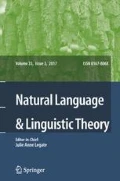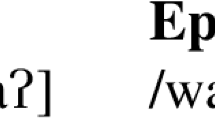Abstract
Many languages respect the generalization that some or all unstressed vowels are deleted. This generalization proves elusive in classic Optimality Theory, however. The source of the problem is classic OT’s parallel evaluation, which requires that the effects of stress assignment and syncope be optimized together. This article argues for a version of OT called Harmonic Serialism, in which the effects of stress assignment and syncope can and must be evaluated sequentially. The results are potentially applicable to other domains where process interaction is best understood in derivational terms.
Similar content being viewed by others
References
Al-Mozainy, Hamza Qublan. 1981. Vowel alternations in a Bedouin Hijazi Arabic dialect: abstractness and stress. PhD dissertation, University of Texas, Austin.
Al-Mozainy, Hamza Qublan, Robert Bley-Vroman, and John J. McCarthy. 1985. Stress shift and metrical structure. Linguistic Inquiry 16: 135–144.
Alderete, John. 2001. Morphologically governed accent in Optimality Theory. New York: Routledge. Rutgers Optimality Archive 309. http://roa.rutgers.edu.
Allen, W. Sidney. 1973. Accent and rhythm. Cambridge: Cambridge University Press.
Anderson, Stephen R. 1974. The organization of phonology. New York: Academic Press.
Anderson, Stephen R. 1992. A-morphous morphology. Cambridge: Cambridge University Press.
Archangeli, Diana, and Douglas Pulleyblank. 1994. Grounded phonology. Cambridge: MIT Press.
Asangkay Sejekam, Nexar. 2006. Awajún. In Ilustraciones fonéticas de lenguas Amerindias, ed. Stephen A. Marlett, Lima: SIL International and Universidad Ricardo Palma. http://lengamer.org/publicaciones/trabajos/awajun_afi.pdf. Accessed 16 June 2008.
Baković, Eric. 2007. Hiatus resolution and incomplete identity. In Optimality-theoretic studies in Spanish phonology, eds. Sonia Colina and Fernando Martínez-Gil, 62–73. Amsterdam: John Benjamins. Rutgers Optimality Archive 813. http://roa.rutgers.edu.
Beckman, Jill. 1997. Positional faithfulness, positional neutralization, and Shona vowel harmony. Phonology 14: 1–46.
Beckman, Jill. 1998. Positional faithfulness. PhD dissertation, University of Massachusetts, Amherst. Rutgers Optimality Archive 234. http://roa.rutgers.edu.
Bennett [Archangeli], Diana. 1981. Pitch accent in Japanese: a metrical analysis. MA thesis, University of Texas, Austin.
Bermúdez-Otero, Ricardo. 2001. Underlying nonmoraic coda consonants, faithfulness, and sympathy. Ms, University of Manchester. http://www.bermudez-otero.com/DEP-mora.pdf. Accessed 16 June 2008.
Bethin, Christina. 1998. Slavic prosody: language change and phonological theory. Cambridge: Cambridge University Press.
Bíró, Tamás. 2006. Finding the right words: implementing Optimality Theory with simulated annealing. PhD dissertation, University of Groningen. http://irs.ub.rug.nl/ppn/298098970. Accessed 16 June 2008.
Black, H. Andrew, 1993. Constraint-ranked derivation: a serial approach to optimization. PhD dissertation, University of California, Santa Cruz. http://www.sil.org/silepubs/Pubs/47751/47751_Black%20A_Constraint%20ranked%20derivation.pdf. Accessed 16 June 2008.
Blevins, Juliette. 1995. The syllable in phonological theory. In The handbook of phonological theory, ed. John Goldsmith, 206–244. Cambridge: Blackwell.
Bliese, Loren F. 1981. A generative grammar of Afar. Arlington, Dallas: SIL International and The University of Texas.
Blumenfeld, Lev. 2006. Constraints on phonological interactions. PhD dissertation, Stanford University. Rutgers Optimality Archive 877. http://roa.rutgers.edu.
Booij, Geert. 1977. Dutch morphology: a study of word formation in generative grammar. Dordrecht: Foris.
Borgstrøm, Carl H. 1949. Thoughts about Indo-European vowel gradation. Norsk Tidsskrift for Sprogvidenskap 15: 137–187.
Campos-Astorkiza, Rebeka. 2004. Faith in moras: a revised approach to prosodic faithfulness. In Proceedings of the North East Linguistics Society 34, eds. Keir Moulton and Mathew Wolf, 163–174. Amherst: GLSA.
Casali, Roderic F. 1996. Resolving hiatus. PhD dissertation, UCLA. Rutgers Optimality Archive 215. http://roa.rutgers.edu.
Casali, Roderic F. 1997. Vowel elision in hiatus contexts: which vowel goes? Language 73: 493–533.
Chomsky, Noam. 1965. Aspects of the theory of syntax. Cambridge: MIT Press.
Chomsky, Noam, and Morris Halle. 1968. The sound pattern of English. New York: Harper & Row.
Churchward, C. Maxwell. 1953. Tongan grammar. New York: Oxford University Press.
Churchyard, Henry. 1999. Topics in Tiberian Biblical Hebrew metrical phonology and prosodics. PhD dissertation, University of Texas, Austin. http://www.crossmyt.com/hc/linghebr/index.html. Accessed 16 June 2008.
Clements, G.N. 1986. Syllabification and epenthesis in the Barra dialect of Gaelic. In The phonological representation of suprasegmentals, eds. Koen Bogers, Harry van der Hulst, and Martin Mous, 317–336. Dordrecht: Foris.
Crosswhite, Katherine. 1999. Vowel reduction in Optimality Theory. PhD dissertation, UCLA.
de Lacy, Paul. 2002. The formal expression of markedness. PhD dissertation, University of Massachusetts, Amherst. Rutgers Optimality Archive 542. http://roa.rutgers.edu.
de Lacy, Paul. 2006. Markedness: reduction and preservation in phonology. Cambridge: Cambridge University Press.
Derbyshire, Desmond. 1985. Hixkaryana and linguistic typology. Dallas: Summer Institute of Linguistics.
Dixon, R.M.W. 1988. A grammar of Boumaa Fijian. Chicago: University of Chicago Press.
Elfner, Emily. 2006. Contrastive syllabification in Blackfoot. In Proceedings of the 25th west coast conference on formal linguistics, eds. Donald Baumer, David Montero, and Michael Scanlon, 141–149. Somerville: Cascadilla Press.
Feldman, Harry. 1978. Some notes on Tongan phonology. Oceanic Linguistics 17: 133–139.
Gafos, Adamantios. 1998. Eliminating long-distance consonantal spreading. Natural Language and Linguistic Theory 16: 223–278.
Goldsmith, John. 1976. An overview of autosegmental phonology. Linguistic Analysis 2: 23–68.
Goldsmith, John. 1990. Autosegmental and metrical phonology. Cambridge: Blackwell.
Goldsmith, John. 1993. Harmonic phonology. In The last phonological rule: reflections on constraints and derivations, ed. John Goldsmith, 21–60. Chicago: University of Chicago Press.
Gouskova, Maria. 2002. Economy of representation and syncope. Handout of talk given at the MIT Phonology Circle, Cambridge, October 17.
Gouskova, Maria. 2003. Deriving economy: syncope in Optimality Theory. PhD dissertation, University of Massachusetts, Amherst. Rutgers Optimality Archive 610. http://roa.rutgers.edu.
Gouskova, Maria. 2007. The reduplicative template in Tonkawa. Phonology 24: 367–396.
Greenstein, Edward L. 1984. The phonology of Akkadian syllable structure. Afroasiatic Linguistics 9: 1–71.
Haas, Mary. 1977. Tonal accent in Creek. In Studies in stress and accent, ed. Larry M. Hyman, 195–208. Los Angeles: University of Southern California.
Hale, Kenneth. 1973. Deep-surface canonical disparities in relation to analysis and change: an Australian example. In Current trends in linguistics, ed. Thomas Sebeok, 401–458. The Hague: Mouton.
Halle, Morris, and Jean-Roger Vergnaud. 1987. An essay on stress. Cambridge: MIT Press.
Hawkins, W. Neil. 1950. Patterns of vowel loss in Macushi (Carib). International Journal of American Linguistics 16: 87–90.
Hayes, Bruce. 1982. Extrametricality and English stress. Linguistic Inquiry 13: 227–276.
Hayes, Bruce. 1987. A revised parametric metrical theory. In Proceedings of the North East Linguistic Society 17, eds. Joyce McDonough and Bernadette Plunkett, 274–289. Amherst: GLSA.
Hayes, Bruce. 1989. Compensatory lengthening in moraic phonology. Linguistic Inquiry 20: 253–306.
Hayes, Bruce. 1995. Metrical stress theory: principles and case studies. Chicago: The University of Chicago Press.
Hockett, Charles. 1948. Potawatomi I: phonemics, morphophonemics, and morphological survey. International Journal of American Linguistics 14: 1–10.
Hoijer, Harry. 1933. Tonkawa. An Indian language of Texas. In Handbook of American Indian languages: Part 3, eds. Franz Boas and Harry Hoijer, 1–148. New York: J.J. Augustin.
Hoijer, Harry. 1946. Tonkawa. In Linguistic structures of Native America, ed. H. Hoijer, 289–311. New York: Viking Fund.
Howard, Irwin. 1972. A directional theory of rule application in phonology. PhD dissertation, MIT.
Hutchinson, Sandra. 1974. Spanish vowel sandhi. In Papers from the Parasession on Natural Phonology, eds. Anthony Bruck, Robert Fox, and Michael La Galy, 184–327. Chicago: Chicago Linguistic Society.
Irshied, Omar, and Michael Kenstowicz. 1984. Some phonological rules of Bani-Hassan Arabic, a Bedouin dialect. Studies in the Linguistic Sciences 14: 109–147.
Ito, Junko. 1990. Prosodic minimality in Japanese. In Papers from the twenty-fifth regional meeting of the Chicago Linguistics Society, part II: parasession on the syllable in phonetics and phonology (CLS 26), eds. Karen Deaton, Manuela Noske, and Michael Ziolkowski, 213–239. Chicago: Chicago Linguistic Society.
Ito, Junko, and Armin Mester. 1992/2003. Weak layering and word binarity. In A new century of phonology and phonological theory: a festschrift for Professor Shosuke Haraguchi on the occasion of his sixtieth birthday, eds. Takeru Honma, Masao Okazaki, Toshiyuki Tabata, and Shin-ichi Tanaka, 26–65. Tokyo: Kaitakusha. (Revision of UC Santa Cruz Linguistics Research Center report published in 1992.).
Ito, Junko, and Armin Mester. 2003. Lexical and postlexical phonology in Optimality Theory: evidence from Japanese. Linguistische Berichte 11: 183–207. http://people.ucsc.edu/~mester/papers/2003_ito_mester_lexpostlex.pdf. Accessed 16 June 2008.
Ito, Junko, Yoshihisa Kitagawa, and Armin Mester. 1996. Prosodic faithfulness and correspondence: evidence from a Japanese argot. Journal of East Asian Linguistics 5: 217–294. Rutgers Optimality Archive 146. http://roa.rutgers.edu.
Johnson, C. Douglas. 1972. Formal aspects of phonological description. The Hague: Mouton.
Kager, René 1989. A metrical theory of stress and destressing in English and Dutch. Dordrecht: Foris.
Kager, René. 1993. Alternatives to the iambic-trochaic law. Natural Language and Linguistic Theory 11: 381–432.
Kager, René. 1997. Rhythmic vowel deletion in Optimality Theory. In Derivations and constraints in phonology, ed. Iggy Roca, 463–499. Oxford: Oxford University Press.
Kager, René. 1999. Optimality Theory. Cambridge: Cambridge University Press.
Kager, René. 2001. Rhythmic directionality by positional licensing. Paper presented at the fifth Holland Institute of Generative Linguistics phonology conference (HILP 5), University of Potsdam, Potsdam, Germany, January 11–13. Rutgers Optimality Archive 514. http://roa.rutgers.edu.
Kenstowicz, Michael. 1983. Parametric variation and accent in the Arabic dialects. In Papers from the nineteenth regional meeting of the Chicago Linguistic Society (CLS 19), eds. Amy Chukerman, Mitchell Marks, and John F. Richardson, 205–213. Chicago: Chicago Linguistic Society.
Kenstowicz, Michael. 1996. Quality-sensitive stress. Rivista di Linguistica 9: 157–187.
Kenstowicz, Michael, and Kamal Abdul-Karim. 1980. Cyclic stress in Levantine Arabic. Studies in the Linguistic Sciences 10(2): 55–76.
Kenstowicz, Michael, and Charles Kisseberth. 1977. Topics in phonological theory. New York: Academic Press.
Kiparsky, Paul. 2000. Opacity and cyclicity. The Linguistic Review 17: 351–367.
Kisseberth, Charles. 1970a. On the functional unity of phonological rules. Linguistic Inquiry 1: 291–306.
Kisseberth, Charles. 1970b. Vowel elision in Tonkawa and derivational constraints. In Studies presented to Robert B. Lees by his students, eds. Jerrold M. Sadock and Anthony L. Vanek, 109–137. Edmonton-Champaign: Linguistic Research.
Kuroda, S.-Y. 1967. Yawelmani phonology. Cambridge: MIT Press.
Lightner, Theodor. 1972. Problems in the theory of phonology, volume 1: Russian phonology and Turkish phonology. Edmonton-Champaign: Linguistic Research, Inc.
Lombardi, Linda. 1995/2001. Why place and voice are different: constraint-specific alternations in Optimality Theory. In Segmental phonology in Optimality Theory: constraints and representations, ed. Linda Lombardi, 13–45. Cambridge: Cambridge University Press. (First circulated in 1995.) Rutgers Optimality Archive 105. http://roa.rutgers.edu.
Malone, Joseph. 1972. The Mandaic syllable-adjustment circuit and its historical origins. In Papers from the eighth regional meeting of the Chicago Linguistic Society, eds. Paul Peranteau, Judith Levi, and Gloria Phares, 473–481. Chicago: Chicago Linguistic Society.
Malone, Joseph. 1992. Diachronic-synchronic dystony: a case from Classical Mandaic. General Linguistics 32: 36–57.
Malone, Joseph. 1997. Modern and Classical Mandaic phonology. In Phonologies of Asia and Africa, ed. Alan S. Kaye, 141–160. Winona Lake: Eisenbrauns.
McCarthy, John J. 1979a. Formal problems in Semitic phonology and morphology. PhD dissertation, MIT.
McCarthy, John J. 1979b. On stress and syllabification. Linguistic Inquiry 10: 443–466.
McCarthy, John J. 1981. Stress, pretonic strengthening, and syllabification in Tiberian Hebrew. In MIT working papers in linguistics 3: theoretical issues in Semitic languages, eds. Hagit Borer and Joseph Aoun, 73–100. Cambridge: Department of Linguistics and Philosophy, MIT.
McCarthy, John J. 1993. A case of surface constraint violation. Canadian Journal of Linguistics 38: 169–195.
McCarthy, John J. 2000. Harmonic serialism and parallelism. In Proceedings of the North East Linguistics Society 30, eds. Masako Hirotani, Andries Coetzee, and Nancy Hall, 501–524. Amherst: GLSA. Rutgers Optimality Archive 357. http://roa.rutgers.edu.
McCarthy, John. 2002. A thematic guide to Optimality Theory. Cambridge: Cambridge University Press.
McCarthy, John J. 2003a. OT constraints are categorical. Phonology 20: 75–138.
McCarthy, John J. 2003b. Sympathy, cumulativity, and the Duke-of-York gambit. In The syllable in Optimality Theory, eds. Caroline Féry and Ruben van de Vijver, 23–76. Cambridge: Cambridge University Press.
McCarthy, John J. 2007a. Hidden generalizations: phonological opacity in Optimality Theory. London: Equinox Publishing.
McCarthy, John J. 2007b. Restraint of analysis. In Freedom of analysis, eds. Sylvia Blaho, Patrik Bye, and Martin Krämer, 203–231. New York: Mouton de Gruyter.
McCarthy, John J. 2008. The gradual path to cluster simplification. Phonology.
McCarthy, John J., and Alan Prince. 1986/1996. Prosodic morphology 1986. Technical Report #32. New Brunswick: Rutgers University Center for Cognitive Science. (Ms privately circulated in 1986, issued in 1996 with new annotations and bibliography.) http://ruccs.rutgers.edu/pub/papers/pm86all.pdf. Accessed 16 June 2008.
McCarthy, John J., and Alan Prince. 1993a. Generalized alignment. In Yearbook of morphology, eds. Geert Booij and Jaap van Marle, 79–153. Dordrecht: Kluwer. Rutgers Optimality Archive 7. http://roa.rutgers.edu.
McCarthy, John J., and Alan Prince. 1993b. Prosodic morphology: constraint interaction and satisfaction. Rutgers University Center for Cognitive Science. Rutgers Optimality Archive 482. http://roa.rutgers.edu.
McCarthy, John J., and Alan Prince. 1994. The emergence of the unmarked: optimality in prosodic morphology. In Proceedings of the North East Linguistic Society 24, ed. Merce Gonzàlez, 333–379. Amherst: GLSA. Rutgers Optimality Archive 13. http://roa.rutgers.edu.
Mester, Armin. 1994. The quantitative trochee in Latin. Natural Language and Linguistic Theory 12: 1–61.
Moreton, Elliott. 2003. Non-computable functions in Optimality Theory. In Optimality Theory in phonology: a reader, ed. John McCarthy, 141–163. Malden: Blackwell.
Nespor, Marina, and Irene Vogel. 1986. Prosodic phonology. Dordrecht: Foris.
Newman, Stanley. 1944. Yokuts language of California. New York: Viking Fund.
Norton, Russell J. 2003. Derivational phonology and optimality phonology: formal comparison and synthesis. PhD dissertation, University of Essex. Rutgers Optimality Archive 613. http://roa.rutgers.edu.
Ohala, Manjari. 1977. The treatment of phonological variation: an example from Hindi. Lingua 42: 161–176.
Paradis, Carole. 1988a. On constraints and repair strategies. The Linguistic Review 6: 71–97.
Paradis, Carole. 1988b. Towards a theory of constraint violations. In McGill working papers in linguistics, vol 5. 1–43. Montreal: McGill University.
Paradis, Carole. 1997. Non-transparent constraint effects in Gere: from cycles to derivations. In Derivations and constraints in phonology, ed. Iggy Roca, 529–550. Oxford: Oxford University Press.
Paradis, Carole, and Fatimazora El Fenne. 1995. French verbal inflection revisited: constraints, repairs and floating consonants. Lingua 95: 169–204.
Payne, David. 1990. Accent in Aguaruna. In Amazonian linguistics: studies in lowland South American languages, ed. Doris L. Payne, 161–184. Austin: University of Texas Press.
Payne, David, Judith Payne, and Jorge Santos. 1982. Morfología, fonología, y fonética del Asheninca del Apurucayali (Campa—Arawak Preandino). Yarinacocha, Peru: SIL International.
Payne, Thomas, and Doris L. Payne. 2001. Panare grammar. Ms, University of Oregon. (Not seen.)
Piggott, Glyne. 1999. At the right edge of words. The Linguistic Review 16: 143–185.
Pike, Kenneth L., and Mildred Larson. 1964. Hyperphonemes and non-systematic features of Aguaruna phonemics. In Studies in language and linguistics in honor of Charles C. Fries, ed. Albert Marckwardt, 55–67. Ann Arbor: English Language Institute, University of Michigan.
Poser, William J. 1985. Cliticization to NP and lexical phonology. In The Proceedings of the West Coast Conference on Formal Linguistics 4, eds. Jeffrey Goldberg, Susannah MacKaye, and Michael Wescoat, 262–272. Stanford: Stanford Linguistics Association.
Poser, William J. 1990. Evidence for foot structure in Japanese. Language 66: 78–105.
Prince, Alan. 1975. The phonology and morphology of Tiberian Hebrew. PhD dissertation, MIT.
Prince, Alan. 1983. Relating to the grid. Linguistic Inquiry 14: 19–100.
Prince, Alan. 1990. Quantitative consequences of rhythmic organization. In Papers from the twenty-fifth regional meeting of the Chicago Linguistics Society, part II: parasession on the syllable in phonetics and phonology (CLS 26), eds. Karen Deaton, Manuela Noske, and Michael Ziolkowski, 355–398. Chicago: Chicago Linguistic Society.
Prince, Alan. 2002. Arguing optimality. In University of Massachusetts occasional papers in linguistics 26: papers in Optimality Theory II, eds. Angela Carpenter, Andries Coetzee, and Paul de Lacy, 269–304. Amherst: GLSA. Rutgers Optimality Archive 562. http://roa.rutgers.edu.
Prince, Alan, and Paul Smolensky. 1993/2004. Optimality Theory: constraint interaction in generative grammar. Malden: Blackwell. (Revision of 1993 technical report, Rutgers University Center for Cognitive Science.) Rutgers Optimality Archive 537. http://roa.rutgers.edu.
Pruitt, Kathryn. 2008. Locality in stress systems. Ms, University of Massachusetts Amherst.
Pyle, Charles. 1972. On eliminating BMs. In Papers from the eighth regional meeting of the Chicago Linguistics Society (CLS 8), eds. Paul Peranteau, Judith Levi, and Gloria Phares, 516–532. Chicago: Chicago Linguistics Society.
Rubach, Jerzy. 1997. Extrasyllabic consonants in Polish: derivational Optimality Theory. In Derivations and constraints in phonology, ed. Iggy Roca, 551–582. Oxford: Oxford University Press.
Selkirk, Elisabeth. 1980. Prosodic domains in phonology: Sanskrit revisited. In Juncture, eds. Mark Aronoff and Mary-Louise Kean, 107–129. Saratoga: Anma Libri.
Selkirk, Elisabeth. 1984. Phonology and syntax: the relation between sound and structure. Cambridge: MIT Press.
Selkirk, Elisabeth. 1995. The prosodic structure of function words. In University of Massachusetts occasional papers in linguistics 18: papers in Optimality Theory, eds. Jill Beckman, Laura W. Dickey, and Suzanne Urbanczyk, 439–470. Amherst: GLSA.
Staroverov, Peter. 2006. Vowel deletion and stress in Tundra Nenets. In Proceedings of the first central European student conference in linguistics, ed. Beáta Gyuris, 1–20. Budapest: Research Institute for Linguistics, Hungarian Academy of Sciences. http://www.nytud.hu/cescl/proceedings/Peter_Staroverov_CESCL.pdf. Accessed 16 June 2008.
Tesar, Bruce. 1995. Computational Optimality Theory. PhD dissertation, University of Colorado. Rutgers Optimality Archive 90. http://roa.rutgers.edu
Thurneysen, Rudolf. 1961. A grammar of Old Irish. Dublin: Dublin Institute of Advanced Studies.
Wiese, Richard. 2001. The structure of the German vocabulary: edge marking of categories and functional considerations. Linguistics 39: 95–115.
Willett, Elizabeth. 1982. Reduplication and accent in Southeastern Tepehuan. International Journal of American Linguistics 48: 168–184.
Willett, Thomas L. 1991. A reference grammar of Southeastern Tepehuan. Dallas: Summer Institute of Linguistics.
Wilson, Colin. 2000. Targeted constraints: an approach to contextual neutralization in Optimality Theory. PhD dissertation, Johns Hopkins University.
Wilson, Colin. 2001. Consonant cluster neutralization and targeted constraints. Phonology 18: 147–197.
Zec, Draga. 2003. Prosodic weight. In The syllable in Optimality Theory, eds. Caroline Féry and Ruben van de Vijver, 123–143. Cambridge: Cambridge University Press.
Author information
Authors and Affiliations
Corresponding author
Rights and permissions
About this article
Cite this article
McCarthy, J.J. The serial interaction of stress and syncope. Nat Language Linguistic Theory 26, 499–546 (2008). https://doi.org/10.1007/s11049-008-9051-3
Received:
Accepted:
Published:
Issue Date:
DOI: https://doi.org/10.1007/s11049-008-9051-3




